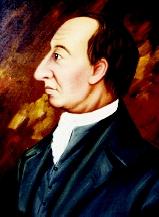Hutton, James
Scottish Geologist
1726–1797
James Hutton was from Scotland and is considered to be the founder of modern geology. After a successful career as a farmer and chemist, he retired at the age of 42 in 1768 to devote the rest of his life to geology. He traveled widely, studying rocks and the processes that formed them.
He presented his "Theory of the Earth" to the Royal Society of Edinburgh in 1785. This was later developed into a book with a similar title in 1795. The book was not well written and did not achieve impact until a book written by a friend and colleague, John Playfair, "Illustrations of the

Two Geological Concepts
In James Hutton's time, much knowledge had been gathered about rocks, fossils, and strata, but it had not been synthesized into a theory of geologic time. Progress was impeded by the "catastrophism" belief of most geologists that the Earth was about 6,000 years old, based on the Biblical notion that most rocks had precipitated from Noah's flood. Hutton held that tremendous periods of time were required to gradually form landscapes and erode them, and the Earth therefore was immensely old.
Hutton achieved two major fundamental ideas that have become foundations of modern geology. The first idea is the doctrine of uniformitarianism. He stated that geologic phenomena can be explained in terms of observable processes which have been at work for long periods of time. The physical geological processes operating today also operated in the past; hence, to learn how rocks were formed in the past, one must study those processes today. "The present is the key to the past" summarizes this thought.
A second idea is the cycle of landscape development. Ordinary processes, which may appear small, yet operating over long intervals of time, can form great changes—as great as those from catastrophic events. Hutton said that mountains are exposed to water and air, and the rocks weather. The landscape is worn down as water erodes the sediments from the rocks and transports them to the sea for deposition. These are eventually compacted and cemented to form sedimentary rocks. Subterranean heat resulting from "plutonism" (deep-seated igneous processes) causes upheaval of the sediments, and mountains are formed, beginning the whole cycle again.
SEE ALSO Erosion and Sedimentation ; Fresh Water, Physics and Chemistry of ; Garrels, Robert ; Stream Erosion and Landscape Development ; Weathering of Rocks .
Scott F. Burns
Bibliography
Porter, R. The Making of Geology—Earth Science in Britain 1660–1850. Cambridge, U.K.: Cambridge University Press, 1977.
Comment about this article, ask questions, or add new information about this topic: